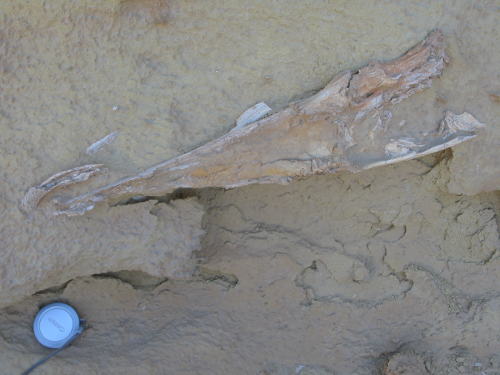Using AI to control energy for indoor agriculture
30 September 2024
Published online 31 March 2017
An Egyptian team documents a new species of fossilized catfish.

Image courtesy of Sanaa El-Sayed
The paleontologists unearthed a near complete fossil of the ancient fish at the UNESCO World Heritage Site otherwise known as Wadi El Hitan and, after analysis, published their study in PLOS ONE1 this month.
Comparing the seawater specimen to other catfish from the Paleogene era, they proved it belongs to a new genus and species, naming it Qarmoutus hitanensis. Fragments of catfish fossils previously found in Egypt, in the Birket Qarun Formation, were freshwater species.
“The preservation of this catfish is spectacular and is the most complete one to be reported from Egypt since 1928,” says Sanaa El-Sayed, lead researcher of the team. With predicted body length up to two meters, its size is rare in catfish fossil records.
The paper lists the parts found, among which are an incomplete neurocranium, the upper and back part of a skull, the catfish’s two opercles which protected its gills, its Weberian apparatus (which connects the swim bladder to the auditory system), as well as a disassociated series of vertebrae. Many of its anatomical characteristics are well preserved.
“Such well-preserved specimens are not easy to find,” says Philip Gingerich, a vertebrate paleontologist at the University of Michigan, and the finder of the fossils of the 37 million-year-old powerful whale Basilosaurus Isis, also at Wadi El Hitan.
The study provides insights into the evolution of the aquatic group, say the scientists.
A theory raised in 2010 about the origin of the marine species family Ariidae, to which the newly discovered catfish belongs, estimated its genesis to be around 40 million years ago. The study confirms the theory and also confirmed that the origin of the fish’s galeichthyinae ariid subfamily is Africa. Only a few catfish crania, found previously, belonged to the same family.
“The new genus Qarmoutus provided additional catfish diversity, filling what was previously a gap in their history for the time and place,” Gingerich says. The researchers want to analyse the evolutionary history of the species and its biological relatives—what paleontologists refer to as phylogenetic relationships. They plan to add more fossils to the family tree.
“We think that adding more fossils into this tree will help to better understand its origin,” El-Sayed says.
Despite decades of intensive paleontological sampling from the 200-square-kilometre reserve, few studies have dealt with the valley’s fish fauna. Qarmoutus hitanensis is the first osteichthyan, or bony fish, found in the area that preserved whales. The Qarmoutus could have been food for archaic whale predators, such as the famous Basilosaurus Isis and Dorudon atrox, Gingerich says.
“Most of the vertebrate paleontologists who worked there were not interested in osteichthyan fishes,” says ElSayed. “The number of ichthyologists, researchers who are studying fossil fishes, around the world is small compared to for example the mammal scientists. This is due to the complexity of the group, huge variation among fishes and the long time span [they occupied], from 500 million years to the present.”
Wadi El Hitan is a fossil 'lagerstätte', a sedimentary deposit that exhibits extraordinary fossils in exceptional condition, explains Gingerich. In the Birket Qarun Formation, which is part of the protectorate, many fossils are preserved in fine sandstone which is not compressible, and hence the fossils are nicely preserved in three dimensions.
The rocks are eroded at the surface, but it helps that much of the erosion in Wadi El Hitan is caused by wind rather than water as the former exposes fossils more incrementally.
The discovery of the catfish was quite lucky. In 2011, during a regular round of prospecting in Wadi El Hitan, co-author of the study and geologist Mohamed Sameh from Egyptian Environmental Affairs Agency came across the fossil.
Sameh collaborated with Hesham Sallam, geology professor at Mansoura University, to unearth it.
The fossil is the first to be excavated, studied, and reported on, by an Egyptian team. It’s currently housed at the Mansoura University vertebrate Paleontology center (MUVP).
The extraction, preparation, and analysis of the specimen took place in Egypt, while the computer analysis took place at the University of Southern California, led by researcher Erik Seiffert. “There are fossils all over Egypt which need to be carefully studied and published, ideally in rigorously peer-reviewed academic journals,” says Seiffert.
The anatomy of living and extinct species is increasingly becoming documented online, and research papers become more accessible in countries like Egypt, he adds. Seiffert says that if biological and fossil specimens are digitized and made available, their analysis will become much less expensive, or in some cases free.
From her side, ElSayed has high hopes for what can be found in the valley. “We are sure that there are more catfish fossils in the sites waiting to be discovered; it was not living alone”.
doi:10.1038/nmiddleeast.2017.57
Stay connected: